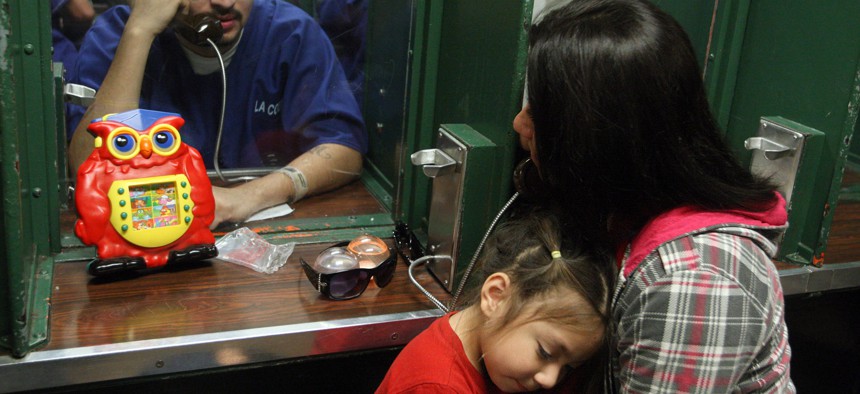Efforts Spreading to Curb Generational Incarceration

Gary Friedman/Los Angeles Times via Getty Images
Spaces for imprisoned parents to bond with their kids and bills to keep them geographically close to those children are gaining traction across the nation.
When children visit their incarcerated parents at the San Francisco County Jail, they meet them in an enchanting, cylindrical room painted a rich yellow with giant smiling bees and toys all around. And if a bill in the California Legislature passes, then the state will be required to place prisoners in the jails closest to their homes.
The child-friendly room and the bill in California are part of a growing trend to help children of the incarcerated stay connected with their parents and to help the imprisoned parents continue to parent their children. Research shows that keeping the parent-child relationship intact helps break the cycle of generational incarceration and also gives the parents a reason to stay out of jail when they’re released.
Legislation to keep prisoners geographically close to their families, called proximity bills, are becoming more common, said Ann Adalist-Estrin, director of the National Resource Center on Children and Families of the Incarcerated at Rutgers University, noting that Massachusetts and Tennessee have similar bills pending.
Estimates for the number of children nationwide who have at least one parent in prison vary from 1.7 million to 2.7 million children, according to a report in the National Institute of Justice Journal. The report’s author, NIJ social science analyst Eric Martin, writes that the number of prisoners skyrocketed after the initiation of the war on drugs in the 1980s, bringing the figures up from 340,000 prisoners in the 1970s to 2.3 million today.
Calling the children of prisoners “hidden victims,” the NIJ report cites research on the deleterious effects parental incarceration has on their children, such as causing antisocial behavior that leads to higher rates of suspensions and expulsions from school, along with economic hardships and other effects.
“This is part of another big issue,” Adalist-Estrin said. When efforts to support children and parents first began in the past few decades, most programs or bills were focused on primary caregivers—usually the mother—but now there’s recognition that both parents need help, such as parenting classes, and proximity to their children, Adalist-Estrin said.
While the movement to create family-friendly spaces for visitation in prison is growing, many prisons have not returned to in-person visits, Adalist-Estrin said. “Video visits are becoming more available. The problem is that it’s sometimes at the expense of in-person visits. And tech companies are saying, ‘We’ll give a discount if you don’t have in-person visitation,’” she said. “We want the video visits, but we don’t want them instead—we want them to supplement in-person visits. That’s a huge issue right now.”
As the effects of parental incarceration on the children of prisoners is becoming more widely recognized, ancillary issues, such as the trauma inflicted on children if they are present at the time of their parent’s arrest, are also seeing reform, Adalist-Estrin said, pointing to new protocols for arresting parents in New York.
Last month, the New York Law Enforcement Accreditation Council, which sets standards for accredited police departments, adopted the new protocols for arresting parents. Examples of new standards include using age-appropriate language with the children present during an arrest and ensuring proper placement regardless of whether the children are present for the arrest. The new policy provides resources and information for police departments to use when writing their policies.
“That’s a first,” Adaslist-Estrin said, though it could not be confirmed whether other states have adopted similar measures.
But beyond the drama of the initial arrest, advocates for children of prisoners say that the anxiety that comes with visiting parents in nearby prisons must also be addressed. “It’s hard and traumatic to bring a child to jail with all the clanging bars and guards with guns,” said Anne Stuhldreher, director of the Financial Justice Project housed in the San Francisco treasurer’s office.
The Financial Justice Project was created in response to news stories about how hard it is for poor people to pay fines and tickets, make phone calls from prison or pay for food and snacks in prison. The project ultimately made it so that phone calls from prisons are free and there is no markup on food sold in prison.
Through her work on financial justice, Stuhldreher said she began to hear requests for a comfortable place where children could visit their parents in prison. The sheriff’s department identified a room for children’s visitation, the city’s library donated books and furniture, and a formerly incarcerated artist painted the mural. An alphabet rug also warms up the floor and there are loads of red and green beanbag chairs.
“We wanted to make that experience more of a healing experience than a traumatic one,” Stuhldreher said.
The Maximum Security Division at Cook County Jail in Chicago has a similar room with toys, books and lots of color.
Stuhldreher thinks it will become increasingly popular for prisons to create cozy and playful spaces for kids to see their family members. “I do think as we learn more about the impacts of incarceration on people’s children, this is an obvious place to start.”





